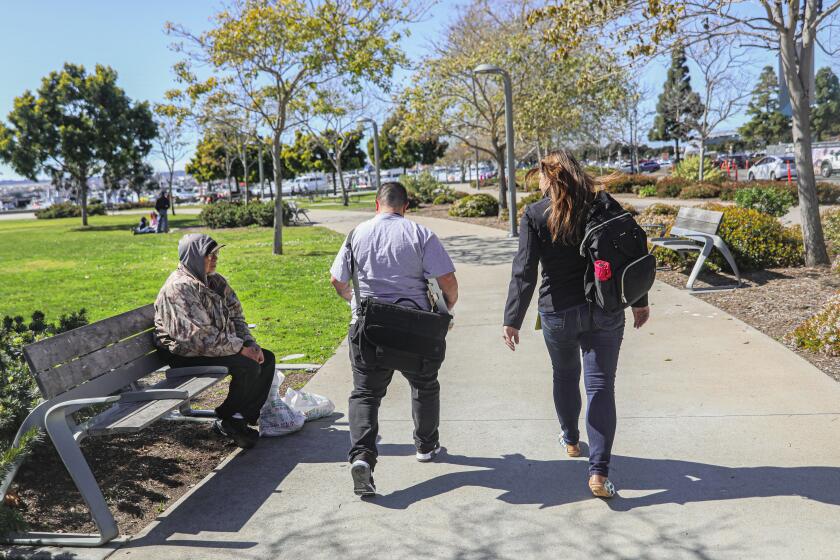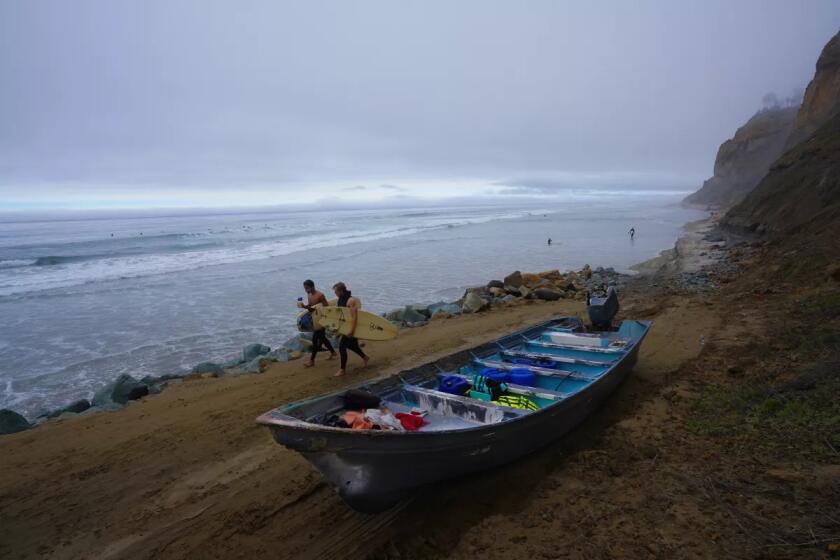County adopts water limits
Most will face three-days-a-week outdoor watering restrictions
County water directors unanimously adopted mandatory conservation measures Thursday that ask families and businesses to reduce their use or face a fine.
In general, the move by San Diego County Water Authority directors to declare a “Level 2” drought alert limits landscape and turf watering to three days per week.
Directors said they know that residents are already conserving about 20 percent more than they did in 2007, but added that the severity of the ongoing drought calls for everyone to tighten up even more. Mark Weston, Poway’s representative on the authority’s board, said he didn’t think the restrictions were too onerous.
“The prohibitions that are listed are really no surprise for San Diego. We’ve been living under that behavior for a long time,” Weston said. “I think they will be readily accepted by our communities.”
Are there more ways your household or business can save water?
Yes 48% (306)
No 52% (335)
641 total votes.
The decision is a strong signal to the authority’s 24 member agencies but is not the final word. Each local water district must now take its own vote to enact the watering restrictions. The city of San Diego, for example, says the restrictions it currently has in place will suffice and the limit on three-day watering will remain voluntary within the city limits.
But given Thursday’s unanimous vote by the water authority, it likely that three-day-a-week watering schedules are just around the bend for most in San Diego County.
Who ends up getting fined for flaunting drought restrictions, on the other hand, is a more delicate question.
While the state water board technically allows each water agency to levy a fine of up to $500 per day for violators, most local drought ordinances start with a simple warning and agencies are gearing up for big education pushes rather than penalties.
Ken Weinberg, the authority’s director of water resources, said mandatory restrictions will not mean a sudden blitzkrieg of water cops.
“I think almost all of the water agencies have a progressive enforcement program,” Weinberg said. “This is not what water agencies want to be doing; we’re in the service business. I think each water agency will tailor their enforcement policy for their customers.”
It’s not as if water districts have a choice. The state can levy a fine of up to $10,000 per day for agencies that do not move to mandatory conservation.
The strong stance is made necessary by a third straight year of drought and record-setting temperatures in the spring. Those temperatures, water authority personnel said, caused water usage in the county to spike this year as many doused cooked landscaping with extra water at a time of the year when consumption is usually low. In the first five months of 2014, water use increased about 10 percent compared to the same period in 2013 when temperatures were more moderate.
County officials point out that usage declined by 27 percent from 2007 through 2013, despite population growth.
The restrictions are designed to stave off potentially bigger cutbacks in 2015.
Maureen Stapleton, the authority’s general manager, noted that residents only have to go back to 1991 to see what a real water crisis looked like. In four months, she noted, the Metropolitan Water District, which then supplied the vast bulk of the region’s water supply, when from voluntary to severe cuts very quickly.
“In less than four months they went from a 5 percent voluntary cut to a 50 percent cut to our region. This is what we want to avoid,” Stapleton said.
A total of 19 county water providers, have pegged their drought level to water authority’s decision and will simply make one additional vote to put it into action.
But others, like the City of San Diego, have not been so direct.
On July 17 San Diego issued a statement noting that the city enacted certain permanent and mandatory water use restrictions in 2009 that “already meet elements of the requirements mandated by the state.”
The city also put voluntary three-day-per-week watering restrictions in place on July 1.
Citing the existing permanent restrictions, which include the requirement to water landscaping between 6 p.m. and 10 a.m., the city stated it would not roll out an “enhanced enforcement system focused on fines.”
The decision did not sit well with some environmental agencies like San Diego Coastkeeper.
Matt O’Malley, who has the title of waterkeeper with the nonprofit, said Wednesday that the recent increase in water consumption proves that every city in the county can do more than it is currently doing to promote conservation.
“I just do not understand why they’re not moving forward with this,” O’Malley said.
Brent Eidson, a spokesman for the city of San Diego Public Utilities Department, said that ongoing water use reductions brought about by permanent restrictions mean that the city is already in line with the state’s reduction goals. He said that the city’s water use numbers increased only about 3 percent year over year compared to 10 percent countywide.
“We are already aligned with their actions,” Eidson said.
He said the city’s water committee will take another look at usage rates in the September or October to determine if more strict restrictions are necessary.
Drought response regulations
Level 1
• Stop washing down paved surfaces, including sidewalks, driveways, parking lots, tennis courts and patios, unless necessary to alleviate a safety or sanitation hazard.
• Stop irrigation water runoff caused by over watering or poorly-aimed sprinklers.
• Irrigate residential and commercial landscape before 10 a.m. and after 6 p.m. to prevent evaporation.
• Use a hose with an automatic shut-off nozzle, or a bucket, to irrigate trees, shrubs and to wash vehicles.
• Nurseries and commercial growers should water their plants between 6 p.m. and 10 a.m. Propagation beds and livestock can be watered at any time of the day.
• Use recirculated water to operate ornamental fountains.
• Serve and refill water at restaurants only upon request.
• Offer hotel guests the option of not laundering towels and linens daily.
• Repair all water leaks within five days.
• Use recycled or non-potable water for construction purposes when available.
Level 2
• Limit commercial landscape irrigation to no more than three assigned days per week on a schedule established by your city’s water manager. From November through May water no more than once per week.
• Limit sprinkler use to no more than 10 minutes per watering station per assigned day. This provision does not apply to extra-efficient drip, micro irrigation or stream rotor sprinkler systems.
• Repair all leaks within 72 hours.
• Stop operating ornamental fountains unless recycled water is used.
Get Essential San Diego, weekday mornings
Get top headlines from the Union-Tribune in your inbox weekday mornings, including top news, local, sports, business, entertainment and opinion.
You may occasionally receive promotional content from the San Diego Union-Tribune.












